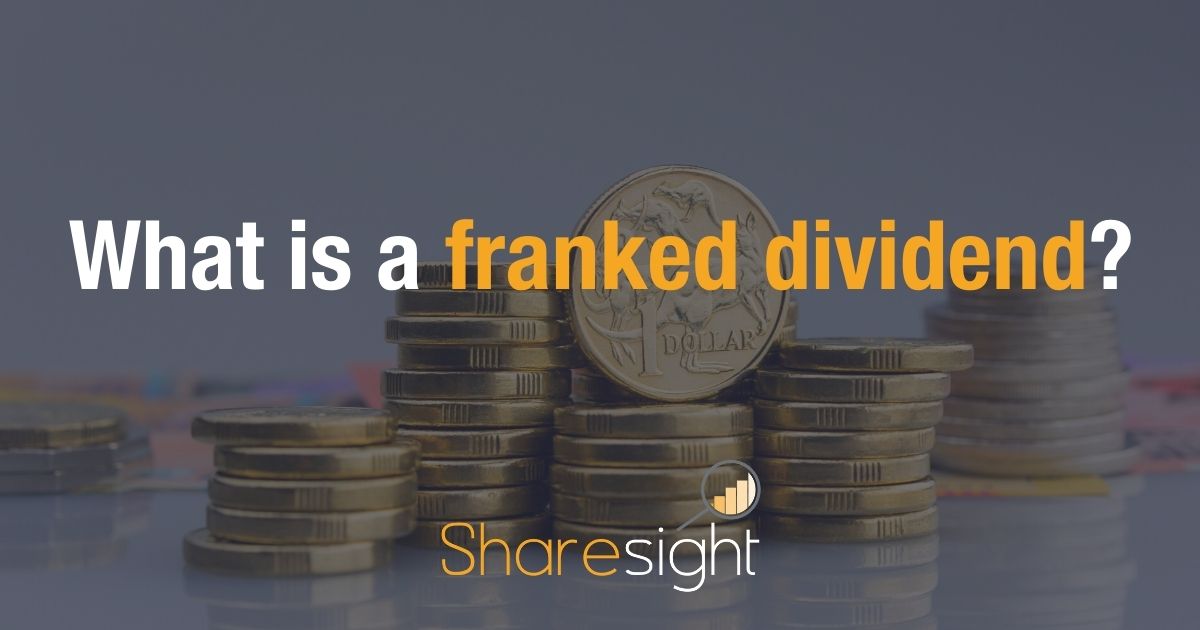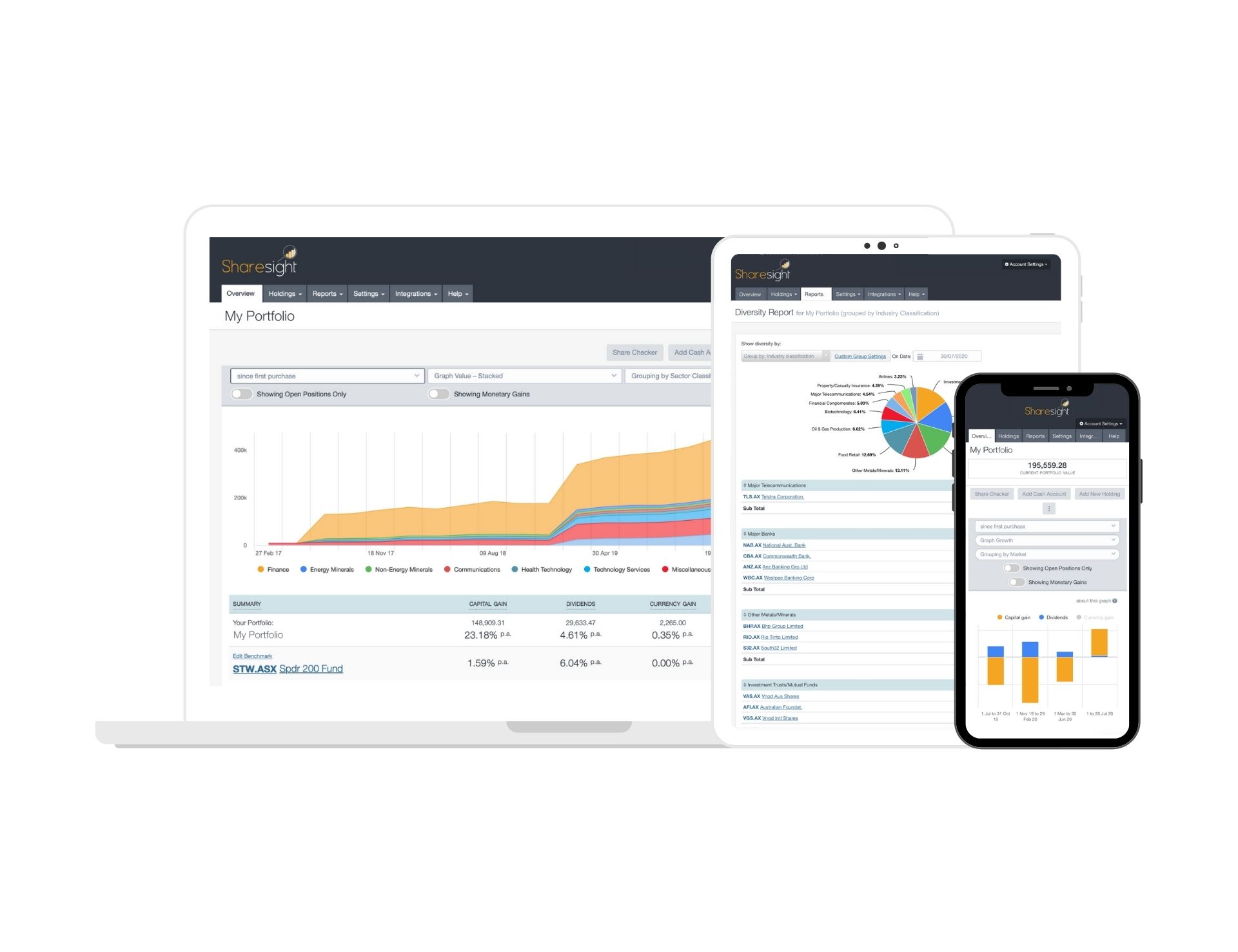What is a franked dividend?
If you invest in Australian shares, you have probably heard of the term "franking credits" or “imputation credits”. Perhaps you have even received franked dividends, without fully understanding what they are or how they are calculated. This blog will explain how franked dividends work, the tax implications they have for investors, and how Sharesight can help investors track dividends in their portfolio.

What is a franked dividend?
Franked dividends were introduced in Australia in 1987, with Australia being the first country in the world to implement the regime. Franked dividends were created with the purpose of stopping the double taxation of company profits. Prior to this, a company’s income could be taxed and then the post-taxed dividends could be taxed at the shareholder’s personal tax rate.
Like individuals, companies pay tax on their earnings, with a flat rate of 30% tax for large companies. As a shareholder, you own a very small part of that company and as such, are often entitled to a share of their profits, in the form of a dividend. If the dividend you receive, however, is taken from the company’s profits after tax, you won’t have to pay tax on it again, avoiding the company’s profit being taxed twice. A dividend that comes from already taxed earnings is known as a "fully franked" dividend.
Franked dividends have what is known as a "franking credit" attached, representing the amount of tax the company paying the dividend has already paid. Franking credits are also often referred to as “imputation credits”. While a large company’s tax rate is 30%, the shareholder’s personal tax rate may be more or less, which is also taken into account. If your maximum tax rate is less than 30%, the Australian Tax Office will refund you the difference in tax paid on your dividends.
How do franked dividends work?
Franked dividends will be paid to you by the company which you are a shareholder of, should they have paid Australian company tax and decide to pay dividends to shareholders. Franked dividends work in the following way:
-
Shareholders receive a dividend notice, within which they will find an item titled "franking credits". Franking credits are the amount of company tax that was paid on that dividend.
-
The shareholder completes their own personal tax return, where they include both the dividend and the franking credit.
-
The shareholder receives a tax credit at the value of the franking credit. This credit can be offset against any other income the shareholder has received. As the flat rate for tax of large companies is 30% and the personal income rate is generally less than that, franked dividends work out as mostly tax-free.
-
As of the year 2000, any difference between the shareholder's tax rate and the tax paid on the dividend will be refunded to them.
It is in this way that franked dividends can not only provide you income but also provide you with a tax rebate.
What is a fully franked and partially franked dividend?
While many companies pay franked dividends, it isn’t required of them to pay tax on the profit they redistribute amongst their shareholders. So while a fully franked dividend has had all the tax paid on it, you may also be given dividends that are partially franked or unfranked. In the case of partially or unfranked dividends, either some or none of the tax has been paid before the shareholder receives the dividend.
Franking is given to the shareholder as a percentage. If a dividend is partly franked 50%, then the 30% large company tax rate has been paid on half of the dividend, but not on the other half.
Partially franked or unfranked dividends are usually the result of the shareholder’s company not making a profit during the financial year, or carrying forward previous losses, consequently lowering their tax rate. When either of these occurs, the company will be subject to less or no tax payments and as a result, dividends they pay will be partially or non-franked.
How do you calculate franked dividends?
Calculating franking credits for a fully franked dividend involves dividing the dividend amount by the company tax rate and then subtracting the dividend amount.
The formula looks like this:
Franking Credit = (Dividend Amount ÷ (1 - Company Tax Rate)) - Dividend Amount
There are a lot of moving parts when it comes to calculating franked dividends, including your personal tax rate and that of the company in which you own shares. Sharesight automatically tracks the franking credits you receive with your dividends and allows you to run a Taxable Income Report, which will calculate the impact of franking credits on your investment performance.
Example of franked dividends
If a shareholder received a fully franked dividend of $70 from a large company with a corporate tax rate of 30%, this is how their franking credit would be calculated:
$70 / (1 - 0.30) - $70 = $30
The franking credit would be $30, added to the original $70, meaning the grossed up dividend would be $100. If the dividend was only 50% franked in this example, their franking credit payout would be $15. With a franking credit, tax only applies to the $70, even though the shareholder would declare $100 taxable income.
This may seem confusing, but tools like Sharesight are built to help Australian investors track their investment portfolios and simplify things like the ins and outs of franked dividends. Sharesight also gives you a clear picture of your investment performance, including factors such as the impact of brokerage fees, franked dividends, and capital gains on your returns.
Are franked dividends taxable income?
All dividends you are paid as a shareholder are part of your taxable income. However, since the introduction of imputation credits in 1987, you can receive a franking tax offset for the tax the company has already paid on its income, which may completely or partially cover the tax payable on the dividends.
Franked dividends can become beneficial at tax time, as if your income tax rate is lower than that of large companies, you may be due a rebate on the tax which was already paid on your franked dividend.
What are the benefits of franked dividends?
There are a few benefits of franked dividends. For the shareholder, they can mean that in some cases, your dividends are already taxed and no further taxes need to be paid on your share of the company profits. Franked dividends can also result in tax rebates if they were taxed at a higher rate than your personal income tax rate. Looking more broadly at franked dividends, since their inception in 1987, they have allowed Australian companies to better manage their capital, which in turn makes these companies more sound investments.
Track franked dividends with Sharesight
With Sharesight, dividends are automatically tracked in your portfolio, inclusive of franking credits and dividend reinvestment plans (DRPs). This eliminates tedious portfolio admin, helping investors save time and money at tax time. Sharesight also includes the impact of dividends and distributions in your returns calculations, along with capital gains, brokerage fees and foreign exchange rates – giving you the full picture of your portfolio's returns.

Track the impact of dividends on your investment performance
With Sharesight’s advanced dividend tracking and performance reporting features, investors can access unparalleled insights into their investments at the click of a button. With Sharesight investors can:
-
Automatically track your dividend and distribution income from stocks, ETFs, LICs and Mutual/Managed Funds – including the value of franking credits
-
Use the Dividend Reinvestment Plan (DRPs/DRIPs) feature to track the impact of DRP transactions on your performance (and tax)
-
Run powerful reports to calculate your dividend income with the Taxable Income Report, portfolio diversity and Capital Gains Tax obligations (Australia and Canada)
-
Easily share access of your portfolio with family members, your accountant or other financial professionals so they can see the same picture of your investments as you do
Sign up for a free Sharesight account and start tracking the impact of dividends on your investment portfolio today!
Disclaimer: The above article is for informational purposes only and does not constitute a product recommendation, or taxation or financial advice and should not be relied upon as such. Please check with your adviser or accountant to obtain the correct advice for your situation.
FURTHER READING

Sharesight users' top trades – December 2025
Welcome to the December 2025 edition of Sharesight’s monthly trading snapshot, where we look at the top buy and sell trades by Sharesight users over the month.

Top trades by UK Sharesight users in 2025
Welcome to the 2025 edition of our UK trading snapshot, where dive into this year’s top trades by the Sharesight userbase.

Top trades by global Sharesight users in 2025
Welcome to the 2025 edition of our global trading snapshot, where we dive into this year’s top trades by Sharesight users around the world.